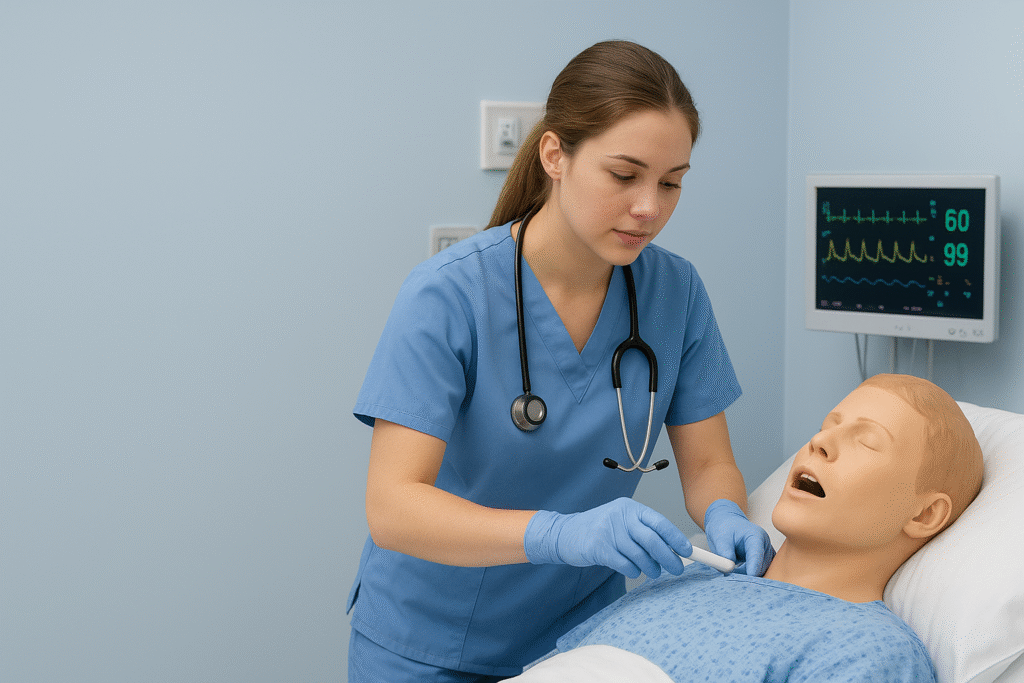

In nursing, confidence and competence grow together. Every choice we make can affect someone’s life, and that level of responsibility takes patience, guidance, and plenty of practice to develop. When I first started nursing school, I quickly realized that while lectures and textbooks helped me understand concepts, real learning happened when theory met practice. But not every student gets enough clinical exposure, and even when we do, the hospital environment can feel intimidating at first. That’s why I believe simulation should be introduced right from the early years of nursing education.
Simulation provides a safe, structured, and realistic space to experience patient care before stepping into the hospital. Whether it’s through manikins, role-play, or virtual scenarios, it lets us apply knowledge, make decisions, and learn from mistakes without the fear of causing harm. This kind of practice builds both confidence and clinical judgment, helping us grow into capable, compassionate professionals.
For me, the most powerful part of simulation is how it turns fear into familiarity. The more we practice, the calmer and more prepared we feel for real situations. To truly understand its impact, here are some of the key benefits of simulation in nursing education:
1. A Safe Space to Learn and Make Mistakes
What I love most about simulation is that it gives us a safe space to learn and even make mistakes. In nursing, the fear of doing something wrong can be overwhelming, but simulation eases that pressure. We can try, reflect, and try again without the risk of harming anyone. This freedom helps us understand where we went wrong and how to improve. With every attempt, we grow more confident and sure of ourselves. By the time we enter real hospital settings, we feel calmer and better prepared. Simulation doesn’t just teach us skills; it builds true confidence in our practice.
2. Strengthening Critical Thinking and Decision-Making
Simulation really pushes us to think on our feet. Every scenario feels real, the patient’s condition changes based on what we do, and suddenly, we’re the ones responsible for figuring it out. We assess, analyze, and decide what to do next, just like in an actual ward. It’s not about memorizing steps anymore; it’s about understanding why each action matters. These moments test our judgment and help us connect theory to real practice. With every simulation, we grow more confident in making quick, thoughtful decisions, and the kind of skill that truly defines a competent and capable nurse.
3. Enhancing Communication and Teamwork
Nursing is never a one-person job, and simulation reminds us of that. During group scenarios, we learn how to communicate clearly, divide tasks, and support each other under pressure, just like in a real hospital. In an emergency simulation, one of us might take the lead, another records details, and others jump in to perform procedures. Afterward, during the debriefing, we reflect on how well we worked as a team. These experiences teach us that good communication and teamwork can change outcomes, and that caring for patients is always stronger when done together.
4. Bridging the Gap Between Theory and Practice
In nursing school, it’s not always easy to connect what we learn in lectures with what actually happens in the hospital. Simulation changes that completely. When we use our classroom knowledge, like anatomy, drug calculations, and understanding diseases on a simulated patient, everything starts to make sense. It’s one thing to read about a condition, but seeing it unfold in a scenario helps us truly understand it. Suddenly, theory turns into action, and learning becomes hands-on, engaging, and real. Simulation makes our education come alive and prepares us to care for patients with both confidence and understanding.
5. Building Confidence and Clinical Competence
The more we practice through simulation, the more confident and skilled we become. Each scenario, whether it’s inserting a catheter, giving medications, or handling a cardiac arrest, helps us refine our techniques until they feel natural. With every session, that nervousness slowly turns into calm assurance. It’s not about being overconfident but about trusting our training and judgment when it matters most. This confidence shows during clinical rotations, where we’re more willing to take initiative and think clearly under pressure. Bit by bit, simulation turns practice into true competence, the kind that stays with us in real care.
6. Encouraging Reflective Learning
After every simulation, we take part in a debriefing session, and that’s where the real growth happens. It’s a chance to slow down, reflect, and talk honestly about what went right, what didn’t, and how we felt during the experience. Our instructors guide us to think about our decisions, teamwork, and communication. These conversations help us see our strengths and the areas we need to work on. It’s not about being perfect but about learning from every experience. This habit of reflection shapes us into thoughtful, self-aware nurses who never stop learning and improving in practice.
7. Promoting Patient Safety Awareness
Simulation has taught me how deeply patient safety is woven into every part of nursing. In these sessions, we face situations like medication errors, infection control issues, or sudden emergencies, but in a completely safe environment. It helps us see how even a small mistake can impact a patient’s well-being. Through these experiences, we learn to slow down, double-check, and follow safety protocols carefully. Over time, these habits become natural. So when we finally step into real clinical settings, we already carry that sense of responsibility and awareness that keeps our patients safe and our care precise.
8. Preparing for Real-World Challenges
Not every nursing student gets the chance to face rare or critical cases during clinical rotations, but simulation makes sure we all do. It prepares us for high-pressure moments like cardiac arrests or obstetric emergencies, helping us stay calm and think clearly. Beyond that, it also teaches us the emotional side of nursing like how to comfort anxious families or communicate difficult news with empathy. These experiences shape us in more ways than we realize. By the time we enter real clinical settings, we’re not just skilled with procedures but emotionally ready to care with confidence and compassion.
Conclusion
Simulation has truly transformed how we learn nursing. It’s more than just a teaching method; it’s a bridge between theory and real patient care. In this safe environment, we build confidence, practice teamwork, and learn to think critically without the fear of making harmful mistakes. Each session helps us grow into more skilled and compassionate caregivers. It prepares us to handle real-world challenges with calm and confidence. For nursing schools, simulation isn’t just about using modern tools. It’s about preparing future nurses who can think clearly, act safely, and care for patients with genuine empathy and purpose.





